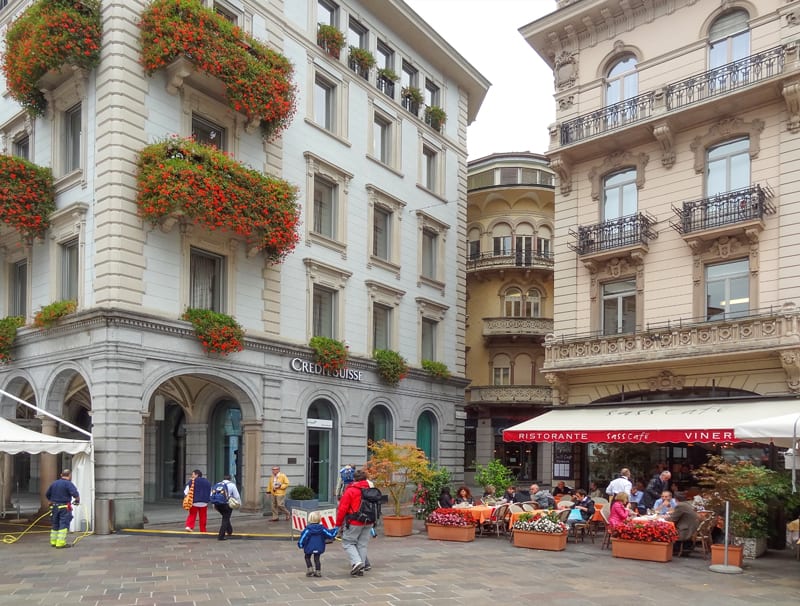
What to do in Lugano, a great little bit of Italy in Switzerland…
Estimated reading time: 11 minutes
By Jim Ferri
For a country its size, it’s incredible how multicultural Switzerland is.
There’s a heavy German influence in the north, and in the southwest, around Geneva, it’s predominantly French. In the east, in the Canton of Graubünden, people speak Romansch, a language closer to Latin than anything else. And in the south, in the Canton of Ticino, a form of Italian called “svizzero Italiano” is spoken.
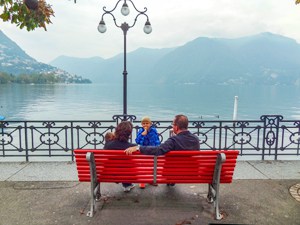
But language isn’t the only thing that differentiates the regions of the country. There’s also Switzerland’s topography and climate. The latter is especially obvious in Ticino.
Ticino has its mountains, as one would expect, but the area also has a Mediterranean climate. Yes, a Mediterranean climate. And believe me, it’s quite a shock the first time you see palm trees in Switzerland.
Lugano, nestled on the shores of the lake bearing the same name, is the jewel of Ticino. It’s a city that stands out, even in the diverse landscape of Switzerland. Located near the Italian border, Lugano’s people, customs, and food bear a distinct Italian influence, making it a unique and fascinating destination.
Lugano is Switzerland’s “Little Italy” and a delightful coalescence of Swiss and Italian cultures. You can get a feel for this wonderful duality in a private immersive tour of Lugano and Morcote, a village further up Lake Lugano. If you’re in Italy, there is also a popular lake cruise from Como to Bellagio and Lugano. All these Viator tours allow free cancellation.
Lugano is also an easy day trip by train from or to Milano, Zurich, and other cities.
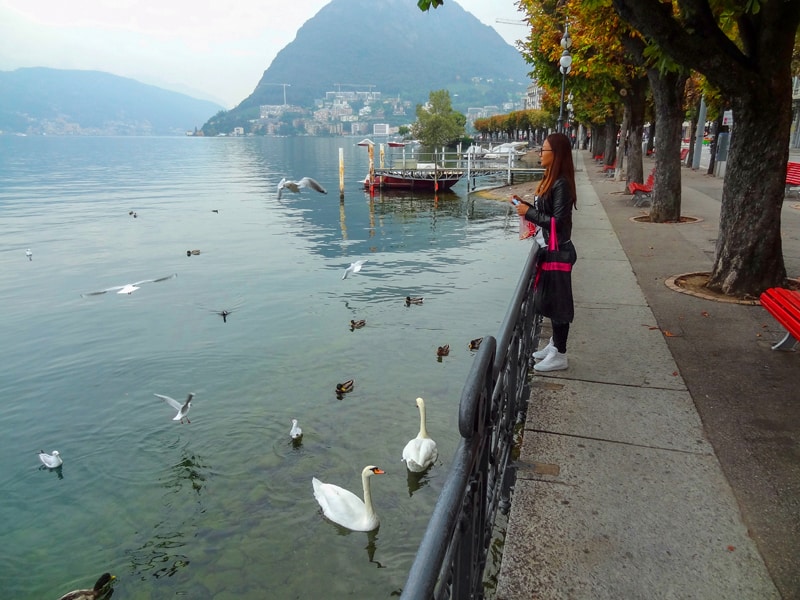
Finding Things To Do in Lugano
I enjoyed it because it’s laid-back and relaxing. There are few tourist things to do in Lugano, just enough to make your visit enjoyable and relaxing. I never needed to see many things and had to rush from a museum to a church to a monument to a gallery, etc. However, I did think that it’s a beautiful old city to wander about and relax—and eat fabulous food, of course.
I arrived in Lugano by train and took a taxi to my hotel. I quickly dropped my luggage in my room and set out to find the best things to do in Lugano. Within minutes, I was out walking along the nearby tree-shaded promenade of Lake Lugano.
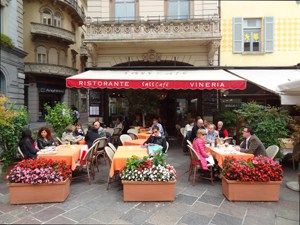
The view of the lake, surrounded by mountains, is beautiful. Everything is quiet and laid-back. Aside from boulevard traffic, most of the activity came from people boarding the Italia for a luncheon cruise on the lake. I watched and thought, what an excellent way to spend an afternoon in Lugano.
Looking out on the tranquil lake, I was mesmerized. Everything was quiet, with only swans and occasional fishermen sliding effortlessly across the water.
Seeing a little city tourist office across the street broke my trance. I crossed over since I had decided to visit Lugano at the last minute, lacked a map, and knew little about the city. I left after just a few minutes, surprised about the little information they had on hand. The only thing they could provide in English about things to do in Lugano was one large brochure.
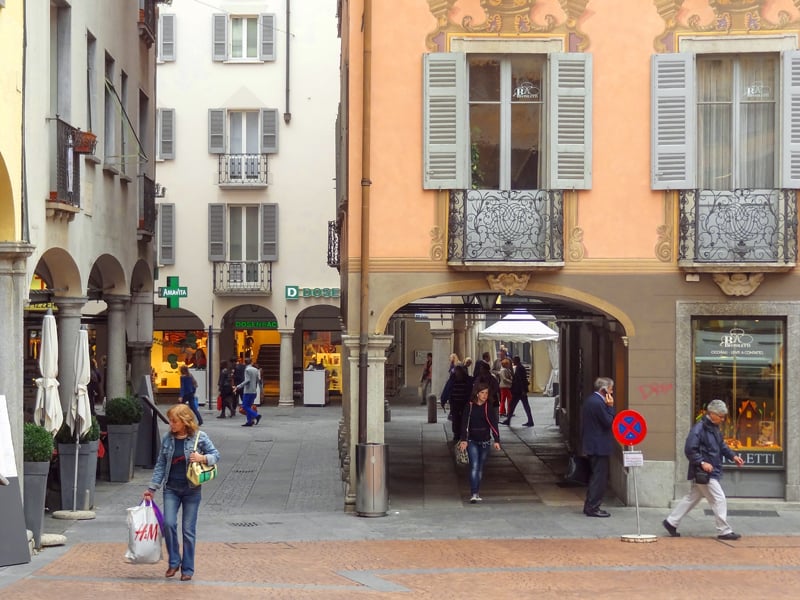
Getting Wonderfully Lost, A Good Thing to Do in Lugano
When I exited the tourist office, I was on the Piazza Riforma. I couldn’t help but notice that the outdoor cafes and ristorantes were already packed for lunch. I also noticed that I was right in the center of the car-free area of Lugano. So, I walked across the piazza and dove into the warren of streets in the picturesque Old City.
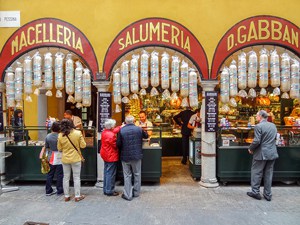
I got lost quickly, which was fortuitous since I love wandering through old cities. However, I quickly realized that no street ran straight, and each ultimately tumbled me into another piazza.
It was apparent the old city was a series of little neighborhoods and piazzas snuggled up next to one another. Multi-colored buildings lined the streets. Café tables flowed out onto walkways, and little food shops were everywhere. There was no doubt I was in Switzerland’s Little Italy.
One of the piazzas I immediately fell in love with was the picturesque Piazza Cioccaro, which oozed with charm.
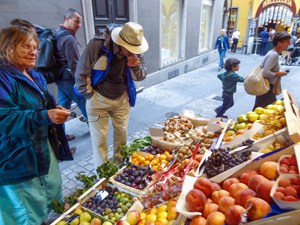
On this search for things to do, I saw the Gabbani, a typical Lugano outdoor bar-ristorante in the hotel of the same name. It was doing a brisk lunch business with the locals, featuring traditional Ticino and Mediterranean cuisine. The Gabbani also had a more formal restaurant upstairs in the hotel.
I was drawn over to the far side of the restaurant by two large woven baskets on stands. They were filled with Panettoncini and Grissini imported from Italy. I then realized they were from the Gabbani gourmet food shop adjacent to the restaurant on the piazza. I entered the shop and found a cornucopia of gourmet products that would make a chef swoon.
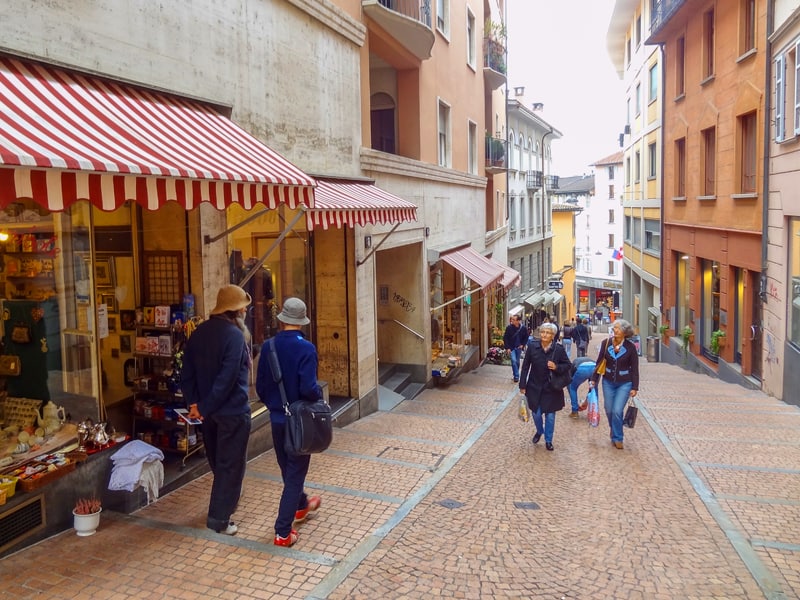
Another Thing to Do In Lugano – Head for Higher Ground
Leaving the piazza, I turned the corner and was shocked to see more Gabbani shops down the street. I headed in their direction but first paused outside a small grocery store.
As I’m sure other Americans are, I was amazed by the colorful variety of vegetables. Among the produce were a half-dozen baskets of different types of mushrooms, all looking as if plucked from the forest floor. It’s almost spell-binding for those of us acclimated to supermarkets back home.
Not far beyond, on Via Pessina, the next corner, I found the Gabbani macellaria, salumeria, and charcuterie. This is more heaven for foodies, I thought.
Wanting to view the city from a higher vantage point, I took the funicolare back to the train station, where I had arrived the previous day. Yesterday, however, I was more interested in finding a taxi than enjoying the view. Now, however, I paused and took it all in.
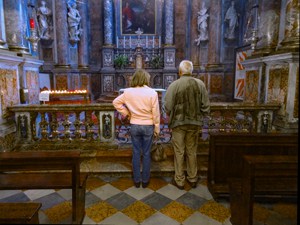
Still searching for more things to do in Lugano, I crossed the street in front of the station and walked down the steps, heading back into the old city. I soon found myself in another delightful little neighborhood. Its cobbled street flowed down the hillside, past small apartments, gelaterias, and many little shops.
The multi-colored buildings lining the street looked like giant children’s building blocks. Every once in a while, I’d come upon a staircase. One was particularly lengthy, making me glad I’d decided to walk down from, not up, to the station.
Wandering down Via Paolo Regazonni, I came to the Cathedral of San Lorenzo-Lugano, its Renaissance bell tower rising over the city. After entering the beautiful church, I found it had a Baroque interior with many frescoes.
Piazza Alighieri Dante
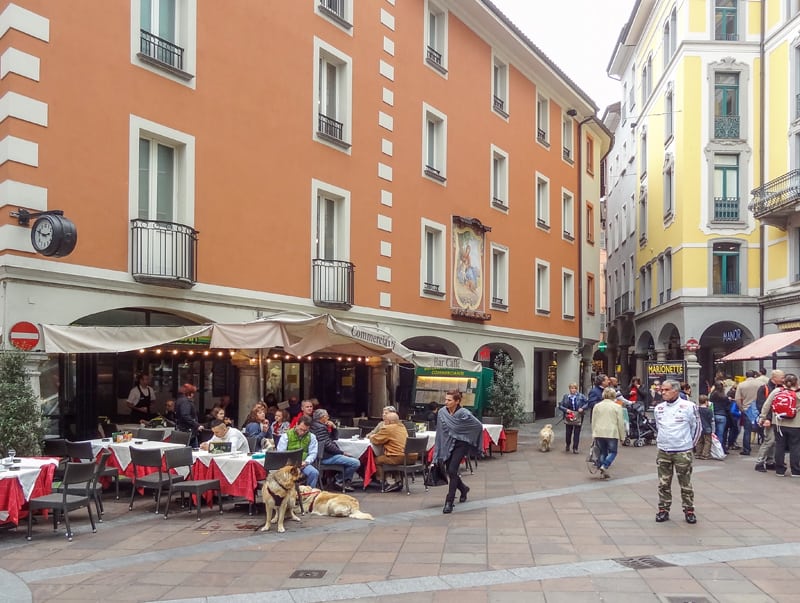
Continuing my search for things to see the next day, I found myself in Piazza Alighieri Dante. It is the commercial center of Lugano’s old city. Home to a department store and several other chain stores. It’s much larger than the other little piazzas I had visited. However, despite its modernity, it was still much older than the historical areas of many American cities.
I watched two men roasting fresh chestnuts at a small stand in the middle of the piazza. One was cooking them over a fire in a bin, the other carefully measuring bags of marroni on a scale. Based on the long line of people waiting to buy a bag, I surmised they must be pretty popular.
Around the corner, I found a little crêpe shop. Next to it was an equally small butcher shop with an entire piglet in its window. Alongside it was a chicken with its head and neck still attached.
I thought it quite odd until I remembered hearing about a Swiss law requiring butchers to leave some animal identification. Supposedly, at one time, a scandal rocked Switzerland when some butchers sold cats as rabbits. Ugh.
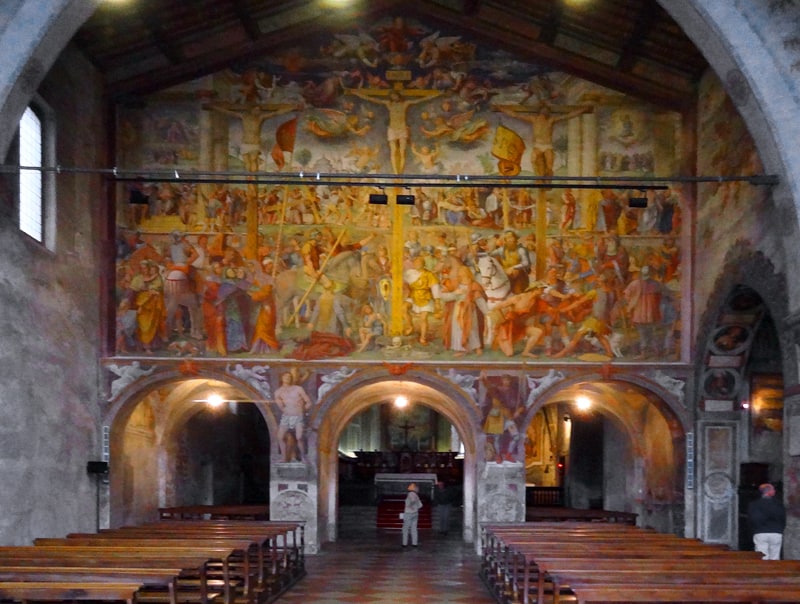
A Great Food Festival, A Historical Church
Lugano is a good city for food lovers. In fact, you’ll find nine Michelin restaurants in this little city.
The city hosts its Festa d’Autunno every year, the annual salute to the start of autumn. Held on the Piazza Della Riforma in late September / early October, it’s one of the best food festivals in Europe. (In several European cities, there are upscale food markets where you can dine on regional foods.)
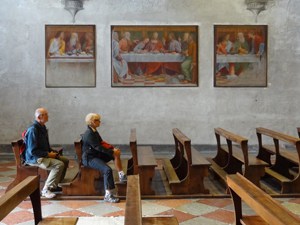
I was now walking across the Piazza Della Riforma, heading back to my hotel. I crossed the boulevard and once again began my saunter along the promenade.
After a few minutes, however, I noticed a couple entering a church on the far side of the boulevard. It was a small Romanesque church, one I had passed several times. But I always assumed it was closed since there was never anyone around it. Now, seeing it open, I crossed the boulevard and found Santa Maria Degli Angioli.
It turned out to be a remarkable church with 16th–century frescoes. One of the frescos is a massive depiction of the crucifixion containing many scenes. It is Switzerland’s most famous Renaissance fresco. Across from four small altars on one sidewall, I found a fresco of the Last Supper. Walking through the archway to the altar area, I found other smaller ones.
If you visit Ticino, see it. It’s one of the best things to see in Lugano.
You may also enjoy: Best Places to Visit in Switzerland / The Lavaux Vineyard Terraces in Switzerland / A Day Trip From Geneva on Switzerland’s Belle Epoque Steamers
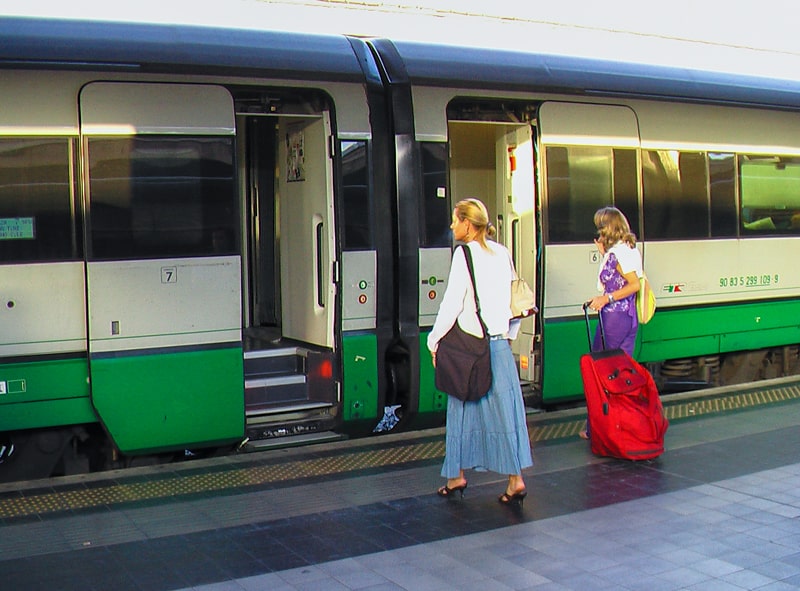
The Trains From Italy
Exiting the church and walking along the lakefront, I remembered training in Switzerland decades earlier. Back then, if a train were late, the Swiss would say, “It must have come up from Italy.”
After taking the funicular yesterday, I stopped at the station and made an onward reservation through Zurich to Innsbruck, Austria. The clerk mapped out a routine for me and handed me the ticket.
She quickly took it back, remarking, “Oh no, it’s better if you take this train, which comes a few minutes earlier. That one is coming from Italy.”
I couldn’t help but think how some things never really change.
Somehow, though, it didn’t bother me. In just a few days, I had adapted well to Ticino’s unique la dolce vita.
If You Go:
Switzerland Tourism
608 Fifth Avenue, Suite 603
New York, NY 10020
https://www.myswitzerland.com
[email protected]
Tel: (877) 231-3523 (toll free)

We will be traveling from the US and visiting Lugano next September and this article was certainly a good planning tool.
Thanks Bubba. Have a great trip!
Jim